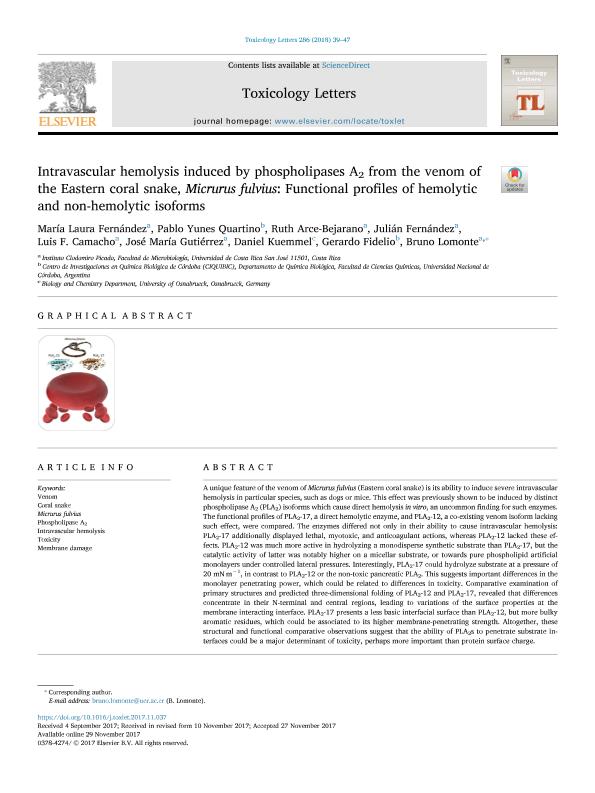Artículo
Intravascular hemolysis induced by phospholipases A2 from the venom of the Eastern coral snake, Micrurus fulvius: Functional profiles of hemolytic and non-hemolytic isoforms
Fernández, María Laura; Yunes Quartino, Pablo Javier ; Arce Bejarano, Ruth; Fernández, Julián; Camacho, Luis F.; Gutiérrez, José María; Kuemmel, Daniel; Fidelio, Gerardo Daniel
; Arce Bejarano, Ruth; Fernández, Julián; Camacho, Luis F.; Gutiérrez, José María; Kuemmel, Daniel; Fidelio, Gerardo Daniel ; Lomonte, Bruno
; Lomonte, Bruno
 ; Arce Bejarano, Ruth; Fernández, Julián; Camacho, Luis F.; Gutiérrez, José María; Kuemmel, Daniel; Fidelio, Gerardo Daniel
; Arce Bejarano, Ruth; Fernández, Julián; Camacho, Luis F.; Gutiérrez, José María; Kuemmel, Daniel; Fidelio, Gerardo Daniel ; Lomonte, Bruno
; Lomonte, Bruno
Fecha de publicación:
04/2018
Editorial:
Elsevier Ireland
Revista:
Toxicology Letters
ISSN:
0378-4274
Idioma:
Inglés
Tipo de recurso:
Artículo publicado
Clasificación temática:
Resumen
A unique feature of the venom of Micrurus fulvius (Eastern coral snake) is its ability to induce severe intravascular hemolysis in particular species, such as dogs or mice. This effect was previously shown to be induced by distinct phospholipase A2 (PLA2) isoforms which cause direct hemolysis in vitro, an uncommon finding for such enzymes. The functional profiles of PLA2-17, a direct hemolytic enzyme, and PLA2-12, a co-existing venom isoform lacking such effect, were compared. The enzymes differed not only in their ability to cause intravascular hemolysis: PLA2-17 additionally displayed lethal, myotoxic, and anticoagulant actions, whereas PLA2-12 lacked these effects. PLA2-12 was much more active in hydrolyzing a monodisperse synthetic substrate than PLA2-17, but the catalytic activity of latter was notably higher on a micellar substrate, or towards pure phospholipid artificial monolayers under controlled lateral pressures. Interestingly, PLA2-17 could hydrolyze substrate at a pressure of 20 mN m−1, in contrast to PLA2-12 or the non-toxic pancreatic PLA2. This suggests important differences in the monolayer penetrating power, which could be related to differences in toxicity. Comparative examination of primary structures and predicted three-dimensional folding of PLA2-12 and PLA2-17, revealed that differences concentrate in their N-terminal and central regions, leading to variations of the surface properties at the membrane interacting interface. PLA2-17 presents a less basic interfacial surface than PLA2-12, but more bulky aromatic residues, which could be associated to its higher membrane-penetrating strength. Altogether, these structural and functional comparative observations suggest that the ability of PLA2s to penetrate substrate interfaces could be a major determinant of toxicity, perhaps more important than protein surface charge.
Archivos asociados
Licencia
Identificadores
Colecciones
Articulos(CIQUIBIC)
Articulos de CENTRO DE INVEST.EN QCA.BIOL.DE CORDOBA (P)
Articulos de CENTRO DE INVEST.EN QCA.BIOL.DE CORDOBA (P)
Articulos(ICYTAC)
Articulos de INST. DE CIENCIA Y TECNOLOGIA DE ALIMENTOS CORDOBA
Articulos de INST. DE CIENCIA Y TECNOLOGIA DE ALIMENTOS CORDOBA
Citación
Fernández, María Laura; Yunes Quartino, Pablo Javier; Arce Bejarano, Ruth; Fernández, Julián; Camacho, Luis F.; et al.; Intravascular hemolysis induced by phospholipases A2 from the venom of the Eastern coral snake, Micrurus fulvius: Functional profiles of hemolytic and non-hemolytic isoforms; Elsevier Ireland; Toxicology Letters; 286; 4-2018; 39-47
Compartir
Altmétricas



